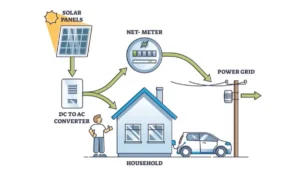HOME IMPROVEMENT
The Benefits of Professional Solar Battery Installation for Your Home

The shift to renewable energy sources has significantly impacted how homeowners approach energy consumption, and solar power stands out as one of the most popular choices. As solar technology advances, many opt for solar battery installations to store excess energy for later use. A solar battery allows you to store unused solar power and access it when your panels aren’t generating electricity, such as at night or on cloudy days. We will explore how professional solar battery installation by North Valley Solar Power can ensure efficiency, safety, and financial savings for homeowners.
Why Professional Solar Battery Installation is Essential for Your Home
Enhanced System Efficiency
The efficiency of your solar energy system is critical in determining its overall performance. A professionally installed solar battery ensures that your energy storage system is configured to maximize efficiency. Without proper installation, there is a risk of energy loss or improper charging cycles, which can reduce the overall benefit of the solar setup. Professionals understand how to integrate the battery into the existing system seamlessly, considering both the solar panels and energy consumption needs. They also help you select the right type and size of battery for your specific requirements. For instance, an installer may recommend a larger battery for homes with higher energy usage to ensure stored energy meets demand during peak times.
Another aspect that impacts efficiency is system compatibility. Solar panels, inverters, and batteries must work harmoniously to function optimally. Professionals ensure the battery is compatible with your solar panel system, avoiding potential inefficiencies or malfunctions. The right installation helps you harness and store the maximum amount of solar energy, ultimately reducing dependency on the grid. By ensuring that your system operates at peak efficiency, you can expect more significant long-term savings on your energy bills and a quicker return on your initial investment.

Increased Safety and Compliance
Safety is one of the most critical considerations when dealing with solar energy and battery installations. Solar battery systems involve high-voltage components that can be dangerous if not installed correctly. A professional ensures that all electrical connections are secure, the system is properly grounded, and safety protocols are followed during installation. This reduces the risk of electrical fires, shocks, or other hazards. Additionally, improper installation may void the manufacturer’s warranty, leaving you responsible for costly repairs or replacements. With a certified installation, you can trust that the system has been set up according to safety guidelines and manufacturer specifications.
Another safety consideration is the location of the battery. Professionals will recommend the best place for the battery installation, considering factors such as ventilation, heat exposure, and ease of access for maintenance. This prevents potential overheating, which could shorten the battery’s lifespan or cause malfunctions. In addition to safety, professionals ensure that the installation complies with local building codes and regulations. In many areas, permits are required for solar battery installations. A professional installer will handle all the necessary paperwork and ensure your system meets the required standards. Compliance with local regulations also prevents legal issues and guarantees that your system qualifies for any available rebates or tax incentives.
Maximizing Financial Benefits
One of the most significant advantages of solar battery installation is the potential for long-term financial savings. Solar batteries allow you to store excess energy during the day and use it when electricity rates are higher, such as during peak hours in the evening. This can help lower your electricity bill substantially, especially if your area has time-of-use (TOU) pricing, where electricity rates fluctuate based on demand. A professionally installed battery ensures that your system is optimized to take full advantage of these pricing models, storing energy when it’s cheapest and using it when prices are at their highest.
Additionally, professional installers can help you navigate incentive programs such as tax credits or rebates. Many regions offer incentives to encourage homeowners to install solar energy systems, including battery storage. By having a professional handle your installation, you can ensure that your system meets all the requirements to qualify for these programs. In many cases, the savings from incentives and reduced energy bills can significantly offset the initial cost of installation, making it a more financially viable option in the long term.
Furthermore, a solar battery can increase the overall value of your home. As more homebuyers look for energy-efficient properties, having a fully installed solar energy system with battery storage can make your home more attractive. Potential buyers will see the benefit of lower energy bills and a reduced carbon footprint, which can make your home stand out from others. By working with a professional, you ensure that the installation is completed to a high standard, boosting the perceived value of the system.
Solar battery installation is an excellent way to enhance your solar energy system’s efficiency, safety, and financial benefits. By opting for professional installation, you ensure your system operates at peak efficiency, complies with safety standards, and maximizes long-term financial savings. Additionally, professional installation extends the battery’s lifespan and provides access to ongoing maintenance and support. Solar battery systems also contribute to environmental sustainability and energy independence, making them a valuable investment for homeowners looking to reduce their reliance on the grid.
Looking for more? Check out our blog for valuable tips.
HOME IMPROVEMENT
How to Future-Proof Your Roof: Choosing Systems That Last Through Climate Extremes

Introduction
The weather isn’t what it used to be.
Maybe you’ve noticed that there are more hailstorms than usual, hotter summers, flash floods, and high winds arriving without warning. Climate patterns have shifted, as has the pressure on your home’s most important protective system: the roof.
In this new reality, roofing is no longer about what looks good or fits the neighborhood style. It’s about resilience. It’s about making long-term choices that withstand heat waves, torrential rain, and bitter cold. It’s about anticipating—not reacting to—the next extreme.
So, if you’re planning a roof replacement or designing a new home, future-proofing isn’t a bonus—it’s a must.
Rethinking What “Durable” Means
Most people assume a roof that lasts 20 to 30 years is “durable.” But that number becomes less impressive when you factor in changing weather patterns and faster material fatigue.
Durability now means more than just lifespan. It includes:
- Thermal resistance: Can it handle temperature swings without expanding and contracting excessively?
- Impact resistance: How does it perform against hail, falling branches, or debris in strong winds?
- Moisture resilience: Will it repel water without absorbing it, even under days of relentless rain?
- Wind rating: Can it stay secure during gusts reaching hurricane levels?
A truly future-ready roof takes all of this into account.
Metal Roofing: The Silent Resilience Champion
In recent years, roofing companies have seen a noticeable uptick in interest in metal roofing. And it’s not just about style—it’s performance-driven.
Metal roofs reflect sunlight, reducing heat absorption during sweltering summers. They’re fire-resistant, can withstand wind speeds up to 140 mph, and resist cracking, warping, or corrosion when properly treated. That means less frequent roof repair and a longer lifespan—often exceeding 50 years.
Metal is becoming the go-to upgrade for homeowners serious about longevity and energy savings, even in regions where asphalt shingles once dominated.
Ventilation Isn’t Optional Anymore
Modern roofing systems must do more than protect from above—they must also regulate from within.
Poor ventilation raises attic temperatures, accelerates roof aging, causes ice damming in winter, and leads to mold and mildew. As temperature fluctuations become more extreme, ventilation helps equalize conditions under the roof deck, reducing pressure on materials and improving indoor comfort.
Future-proofing means integrating ridge vents, soffit vents, and proper airflow strategies into every roof installation—not as afterthoughts, but as essentials.
Color and Coating: More Than Aesthetic
Color choice used to be a curb appeal decision. Now, it’s a climate tool.
Light-colored or reflective roofing materials can reduce surface temperature by 50°F or more in summer, cutting cooling costs and reducing thermal wear. Special coatings—like solar-reflective paint or ceramic granules—can boost UV resistance and slow degradation.
As temperatures rise across the country, smart color choices can mean the difference between efficiency and early failure.
Composite and Synthetic Materials
Innovation in roof replacement isn’t limited to metal and traditional materials. Composite shingles made from recycled polymers or synthetic slate alternatives offer the look of natural materials with enhanced performance.
These new systems resist rot, insects, fire, and severe weather, often being lighter and easier to install. Environmentally conscious homeowners also contribute to sustainability goals by reducing landfill waste and using post-consumer materials.
It’s the future meeting the familiar, without sacrificing beauty or function.
Gutters, Flashing, and Drainage: The Overlooked Trio
If you’re thinking about future-proofing, don’t stop at shingles.
Proper drainage is crucial. Gutters should be wide enough to handle heavy rain volume, sloped correctly to avoid pooling, and fitted with guards to reduce clogging. Flashing should be corrosion-resistant and sealed against uplift. Valleys and edges should direct water cleanly and consistently.
Water is persistent. A roof that sheds it efficiently is one that stays dry, strong, and safe—even in the face of a 100-year storm.
Ridge Runner Roofing on Staying Ahead of the Curve
Homeowners across Western North Carolina have already begun to rethink how they build and maintain their homes for the future. Ridge Runner Roofing, with experience grounded in regional climate trends, knows that forward-thinking design isn’t a luxury—it’s a necessity.
The team believes in crafting solutions that address not just today’s weather but tomorrow’s. Resilience isn’t built overnight. It’s built one choice at a time, layer by layer.
Maintenance Still Matters
Even the best roof systems need attention.
Future-proofing isn’t just about installation; it’s about ongoing awareness. Homeowners should inspect their roof (or have it inspected) twice a year and after major storms. They should also keep gutters clear and look for small issues before they become expensive ones.
Preventive maintenance isn’t about paranoia. It’s about respect—for the investment and for the home beneath it.
Think 20 Years Ahead, not 5
Consider how the climate might change when planning a roof repair, roof installation, or full replacement. Will summers be hotter? Winters are more severe. Will storms grow in intensity and frequency?
Choose materials and designs with those possibilities in mind. It might mean a higher up-front cost, but the long-term valuing durability, comfort, energy savings, and safety—pays dividends.
Because roofs aren’t just shelter. They’re strategy.
HOME IMPROVEMENT
Hamro Solar LLC: Pioneering Sustainable Energy for a Greener Future

Hamro Solar LLC is a company that aims to eliminate the traditional ways of energy consumption by opting for solar power as the core solution. Being a solar company whose mission is to help people and businesses avoid leaving carbon footprints and become stewards of the world earth, Hamro Solar LLC offers unparalleled solar energy solutions that can help users generate their electricity and reduce expenses on centralized energy.
History and Background
It was established to provide solar energy all over the country and the company has rapidly expanded over the past few years. It was founded by a team of people, all of whom shared a similar passion for the increasing environmental changes that demanded change through the adoption of clean energy solutions. Hamro Solar Company has grown over the years to offer many services to its customers apart from only installing solar panels and improving its technology. These days it is recognized for its customer focus, quality, and efforts towards renewable energy sources.

Services Offered by Hamro Solar LLC
Hamro Solar LLC offers a comprehensive range of services designed to meet the unique energy needs of its clients. These services include:
Solar Panel Installation
Hamro Solar provides end-to-end solar panel installation services, from initial consultation and site assessment to design, installation, and maintenance. The company uses high-quality, efficient solar panels that maximize energy production and ensure long-term reliability.
Energy Management Solutions
Understanding that effective energy management is key to maximizing the benefits of solar power, Hamro Solar offers advanced energy management systems. These systems allow clients to monitor and optimize their energy consumption, reducing waste and enhancing the overall efficiency of their solar installations.
Energy Storage Systems
Hamro Solar LLC offers energy storage services which remains one of the best among the services offered by the company. Through battery storage technology, the clients can store the excess energy produced during the day for use at night or in case of bad weather. It also further boosts the grid reliability capacity and independence in addition to improving the grid efficiency.
Benefits of Energy Storage:
- Reliability: Battery storage systems ensure that there is a steady power supply, now and again, when the sun is not shining, or when the demand rises very high.
- Grid Independence: Through obtaining more storage spaces for energy, clients will be able to ration the amount of energy they need from the grid hence cutting expenses and additional costs of energy security.
- Efficiency: Energy storage when generation is high and using that stored energy when needed optimizes the use of the solar installations, improving the overall system efficiency.
Customized Solar Solutions
As for the methods, the Hamro Solar LLC company mainly focuses on the individual approach for each client and the subsequent adjustment of the offered solar solution. For the homeowner renovating a house or a business constructing a new building, the company’s specialists make proper studies and then implement energy-efficient systems that offer excellence in results and efficiency for the least amount of money invested.
Solar Energy Solutions for Homeowners
With regards to homeowners, for instance, the use of solar energy has several benefits for every person. Hamro Solar LLC mainly operates in residential solar that can be described to be cheap yet very effective at the same time. At the moment, instead of using normal sources of electricity, some people are using solar power through rooftop solar panels placed in strategic places to produce electricity for their homes hence in the process they spend a lot of money on electricity bills. Also, the electricity from solar is emissions-free meaning that the homeowners will be conserving the environment besides ensuring they do not rely on foreign energy.

Commercial and Industrial Solar Solutions
For business and industry clients, Hamro Solar LLC has utility-scale solar systems that can be used to provide power for entire complexes and factories among others. These solutions aim at satisfying the energy requirements of organizations, especially the ever-rising energy demands, help organizations to cut costs, and at the same time support sustainability measures.
Solar Panel Technology and Quality
Hamro Solar LLC is known for using solar panels, which are sourced from some of the best manufacturers globally, and are of high quality and incorporating the latest technology. The solar panels that are incorporated in installation services offered by Hamro Solar are reputable for high efficiency, relatively long durability, and fine performance under low light conditions. This way, solar clients get the most value from their PV investments regardless of where they are or the climate they are subjected to.
Features of Hamro Solar Panels:
- High Efficiency: Hamro Solar has come up with solar panels that are more efficient in the way they capture sunlight and the amount of electricity produced as compared to conventional solar panels.
- Durability: High quality and fully tested, the solar panels at Hamro Solar are designed for longevity and come through even extreme heat, rainfall, and snow.
- Warranty and Support: Every panel is backed by durable warranties for the panels and the installation work, and clients are guaranteed the best services.
Environmental Impact and Sustainability
Environmental conservation is another major consideration that fuels the operations of Hamro Solar LLC in its provision of sustainable solar solutions. Solar energy is an abundantly accessible and clean source of power that does not emit any pollution during its utilization, thus making it suitable for electricity production to minimize emissions. Clients thus have a chance to contribute to combating climate change and preserving the environment by choosing Hamro Solar.

Steps in the Installation Process:
- Consultation and Assessment: This is a meeting to establish the consumer’s energy requirements, develop a site survey profile, and find out the suitable solar solution to recommend.
- Design and Proposal: A solar system plan is developed and a formal quotation which includes a cost estimate, projected savings, and period of implementation is given to the client.
- Installation: Hamro Solar has certified technicians to carry out installation so that everything is done right and on time.
- Inspection and Activation: Inspection that takes place after installation checks on whether the system meets safety and performance requirements. As soon as the connection receives approval, a client can begin producing their solar energy.
- Ongoing Support: Maintenance and support services are offered by Hamro Solar hence can help you to maintain the system at the highest performance.
Warranties and Guarantees
Of the strategies that Hamro Solar LLC has adopted to differentiate itself in the industry, one that stands out is warranties and guarantees. Every system and product that has been installed has its standard warranty that covers the functionality of the equipment as well as the work done in the installation process. These elements of commitment to quality and customer satisfaction give the clients a sense of assurance regarding their investment with Hamro Solar and that the company fully supports its products.
HOME IMPROVEMENT
The Journey of a Renovation: A Dumpster’s Story

Introduction
It began with a blueprint, a faded kitchen wall, and a dream too long postponed. Jamie stood in the doorway of her 1960s ranch-style home, eyes darting between peeling wallpaper and scuffed baseboards. She exhaled deeply. This was the year. The renovation was finally happening.
What she didn’t expect, however, was how integral one oddly unglamorous thing would become: a dumpster.
Not just any dumpster—but the one from Axis Dumpsters, which arrived on a crisp Monday morning like a silent sidekick ready for the dirty work ahead.
Phase 1: Out with the Old
Jamie had hired a crew for the demolition, but her own hands were the first to pry away outdated tile from the kitchen floor. Within hours, fragments littered the ground, jagged and dusty. What she thought would be manageable quickly transformed into a mountain of mess.
The rented container out front became more than a bin—it became the heart of the operation. A 20-yard construction dumpster rental absorbed the debris like a pro: broken cabinets, crumbled drywall, water-damaged wood from a hidden leak she hadn’t planned for.
Her neighbors passed by, raising eyebrows and waving politely. One even asked where she got it. “From Axis Dumpsters,” she replied. “They were easy to work with.”
Phase 2: Surprises and Setbacks
As the project moved into week two, the scope expanded. The backyard fence had to come down. The garage, once a holding cell for forgotten boxes, was finally tackled. Jamie had underestimated how much it needed to go.
With every trip outside, another load found its place in the dumpster: rusted tools, a cracked mirror, an exercise bike no one had used since 2014. Her shoulders ached, but it felt good. Letting go of clutter was more than physicality was emotional.
The container filled steadily, and she called to schedule a pickup and switch-out. Another one arrived on time, smoothly as clockwork.
Phase 3: An Unexpected Visitor
Halfway through her project, Jamie’s sister arrived for the weekend. “I thought you were just remodeling a kitchen,” she said, stepping over old baseboards.
Jamie laughed. “It started with that. Now it’s kind of everything.”
They sat in lawn chairs on the front porch, sipping lemonade, watching the sun dip behind the horizon—and the dumpster, half-filled again.
“I might borrow one of those when I do my garage next spring,” her sister said, motioning toward it.
Jamie nodded. “Definitely do. Whether it’s for a renovation or a residential dumpster rental for a big cleanup, it just simplifies everything.”
Phase 4: Room by Room
By the third week, Jamie was deep into painting and rebuilding. The new countertops were in; lighting fixtures dangled with promise. Every time something new was installed, something old had to be tossed.
Her contractor appreciated the setup. No delays. No mess cluttering the work site. Just an efficient way to manage the chaos that renovation always brings.
Even the old insulation, once jammed into crawl spaces, now had a home—out of the house and into the bin.
Phase 5: Reflecting on the Chaos
Looking back, Jamie realized that renting a dumpster wasn’t something she gave much thought to when she started planning her remodel. But it became central to the flow of everything.
In a world of Pinterest boards and sleek renderings, it’s easy to forget the dirty middle part. The discarded layers, the cluttered corners, the sheer volume of “stuff” we live with.
Dumpster rental doesn’t make the list of “exciting” things during a renovation, but it quietly becomes essential. From large-scale renovations to smaller efforts, having a plan for waste sets the tone for everything else.
Why More People Are Renting Than Ever
Jamie isn’t alone. Across the country, homeowners are jumping into renovation and remodeling projects—and finding out the hard way how much waste even a small project can generate.
Construction dumpster rental isn’t just for contractors anymore. It’s for moms turning basements into home offices. It’s for retirees purging years of clutter before a move. It’s for DIYers who’d rather not make 12 trips to the landfill.
The rise in residential dumpster rental demand has pushed companies to adapt, offering flexible scheduling, multiple size options, and quick turnarounds.
Thinking Bigger Than Renovation
Dumpster rentals don’t end when the last coat of paint dries. After her kitchen was finished, Jamie found herself using the final days of her rental period to do something unexpected: she tackled the attic.
Old books, broken lamps, childhood school projects (the ones not worth saving), and outdated electronics all made their way down the ladder and into the container.
As she tossed in the final cracked storage bin, she felt lighter. It wasn’t just about waste—it was about reclaiming space.
A Tool, Not Just a Container
When the final dumpster was picked up and the driveway clear, Jamie stood on her porch again—same spot, different view. Her house felt renewed, but so did her relationship with the idea of “stuff.”
She knew now that a simple tool—a steel box with no moving parts—could dramatically shape the success of a project.
And somewhere in that lesson was the silent role Axis Dumpsters played—not in the design, not in the paint, but in the flow. In making room, literally and metaphorically, for something new.
The Final Thought
The next time someone asks Jamie how she pulled off such a smooth renovation, she’ll have a few expected answers: a great contractor, patience, and detailed planning.
But she’ll also say this: Don’t underestimate the power of a good dumpster rental. It keeps the momentum moving. It keeps the site clean. And it keeps your sanity intact.
And yes—she’ll remember to mention Axis Dumpsters. Just not with fanfare. With quiet appreciation.
-

 BIOGRAPHY1 month ago
BIOGRAPHY1 month agoBehind the Scenes with Sandra Orlow: An Exclusive Interview
-

 HOME7 months ago
HOME7 months agoDiscovering Insights: A Deep Dive into the //vital-mag.net blog
-

 HOME10 months ago
HOME10 months agoSifangds in Action: Real-Life Applications and Success Stories
-

 BIOGRAPHY8 months ago
BIOGRAPHY8 months agoThe Woman Behind the Comedian: Meet Andrew Santino Wife




























